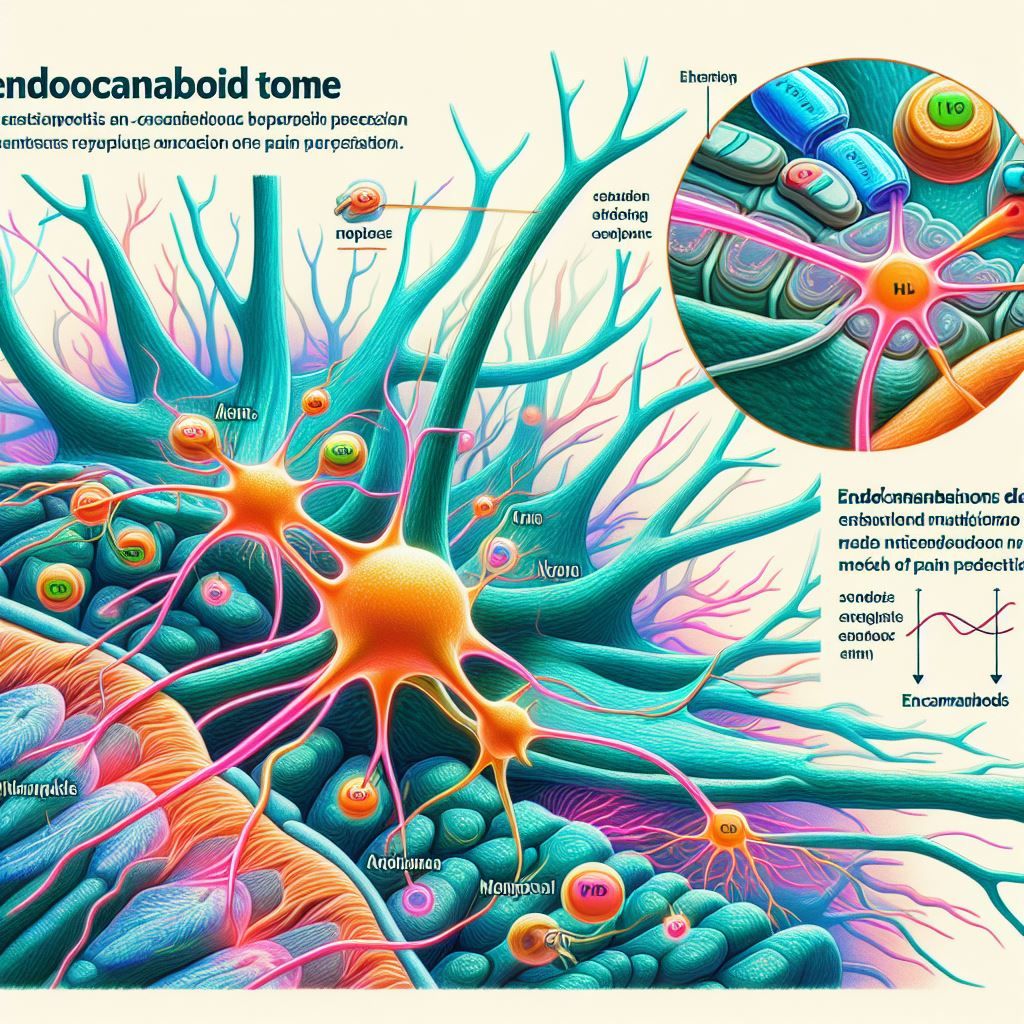Endocannabinoid Tone and Pain
The Significance of Endocannabinoid Tone in Achieving Effective Pain Management

Understanding Endocannabinoid Tone and Its Role in Pain Management
The endocannabinoid system (ECS) is a complex cell-signaling system in the body that helps regulate many important functions like pain, mood, appetite, inflammation, and more. The ECS does this through the production of its own endogenous cannabinoid compounds (endocannabinoids) that bind to cannabinoid receptors throughout the body and brain.
Defining endocannabinoid tone and its relevance in pain management
Endocannabinoid tone refers to the overall activity level of the ECS at any given time. This includes factors like:
- Concentrations of endocannabinoids like anandamide and 2-AG
- Density and sensitivity of cannabinoid receptors
- Functionality of enzymes that synthesize or break down endocannabinoids
Having optimal endocannabinoid tone is important for keeping many biological processes, including pain perception, running smoothly. Research shows that low endocannabinoid tone is associated with increased sensitivity to pain.
Overview of the endocannabinoid system (ECS) and its significance in the UK healthcare context
The discovery of the ECS over the past few decades has greatly improved our understanding of how cannabis provides therapeutic effects. There is growing recognition within UK healthcare that modulating the ECS through exogenous cannabinoids or lifestyle changes could benefit certain patients.
For example, NHS guidelines now allow specialist doctors to legally prescribe medical cannabis containing THC and CBD to patients with conditions like chronic pain or epilepsy when other treatments have failed. The ECS is also being explored as a target for new, non-intoxicating pain medications.
Historical perspective of cannabis and its association with pain relief
Cannabis has been used medicinally for thousands of years, including as an analgesic and anti-inflammatory. In the 19th century, cannabis extracts were commonly prescribed by doctors to treat pain conditions like migraines, arthritis, and the pain of childbirth.
However, cannabis was prohibited in most countries in the 20th century due to its intoxicating effects. Only recently have scientists discovered the ECS and its role in mediating cannabis' therapeutic benefits, sparking renewed interest in cannabis medicines.
The Science Behind Endocannabinoid Tone
The endocannabinoid system (ECS) plays a crucial role in regulating pain perception and pathways. The two main cannabinoid receptors involved are:
Explanation of cannabinoid receptors CB1 and CB2
- CB1 receptors: Mostly found in the central and peripheral nervous system. They mediate the psychoactive effects of cannabinoids and regulate neurotransmission.
- CB2 receptors: Mainly expressed in immune cells. They modulate immune system response and inflammation.
The relationship between endocannabinoid levels, receptor function, and pain perception
Higher endocannabinoid levels and greater receptor density is associated with reduced pain perception. Endocannabinoids like anandamide (AEA) and 2-AG dampen pain signals by:
- Binding to CB1 receptors in the nervous system
- Activating CB2 receptors on immune cells
- Inhibiting pain neurotransmitter release
Insights into how endocannabinoids influence pain pathways
Endocannabinoids regulate both ascending and descending pain pathways in the nervous system. For example:
- They inhibit transmission of pain signals from the periphery to the brain
- They activate descending pathways that suppress pain
- They reduce inflammation and immune cell activation that triggers pain
In summary, endocannabinoids like AEA and 2-AG can control pain by binding to CB1 and CB2 receptors throughout the body.
Endocannabinoids and Nociception
Endocannabinoids like anandamide (AEA) and 2-arachidonoylglycerol (2-AG) play an important role in regulating pain pathways in the body. The endocannabinoid system (ECS) influences both acute and chronic pain states through its signaling effects. Understanding this system is key for developing better therapies for pain management.
How endocannabinoids impact pain pathways
Endocannabinoids bind to cannabinoid receptors found throughout the central and peripheral nervous systems. This regulates neurotransmission and impacts how our bodies perceive and respond to painful stimuli. Specifically:
- AEA and 2-AG activate CB1 receptors found on nerves to inhibit pain signals
- Activation of CB2 receptors on immune cells mediates inflammation involved in chronic pain
- Overall, endocannabinoids suppress pain transmission through these receptor pathways
The ECS's influence on acute and chronic pain
Signaling through the ECS has different effects on acute versus chronic pain:
- In acute pain, the ECS activates to suppress initial pain signals and resolve this transient pain state
- In chronic pain, ECS signaling becomes dysregulated, contributing to heightened pain sensitivity and inflammation over long periods
Therefore, while ECS activation is protective in acute pain, its dysfunction can promote chronic pain. Targeting this system may require different approaches for treating acute versus persistent pain syndromes.
Role of ECS signaling in nociception
Under normal conditions, the ECS helps regulate nociceptive pain pathways and promotes resolution of acute pain. This includes:
- Suppressing pain signal transmission from peripheral nerves to the spinal cord and brain
- Activating descending pathways that inhibit pain signaling
- Reducing inflammation and sensitization related to tissue injury
Through these mechanisms, proper ECS tone facilitates normal nociceptive processing and the subsidence of acute pain once underlying tissue damage has healed.
The ECS and Its Role in Chronic Pain and Depression
There is a strong link between chronic pain conditions and depression. Studies show that up to 80% of chronic pain patients also suffer from major depressive disorder. This comorbidity significantly worsens quality of life and can increase the risk of suicide.
Linking the dysregulation of the ECS with chronic pain syndromes and depressive disorders
Research indicates that dysfunction in the endocannabinoid system (ECS) is implicated in both chronic pain and depression. The ECS helps regulate physiological processes like mood, pain perception, and inflammation. When the ECS is disrupted, endocannabinoid tone decreases, leading to an imbalance in these systems.
For example, patients with fibromyalgia, arthritis, and neuropathic pain often have reduced levels of the endocannabinoids anandamide (AEA) and 2-arachidonoylglycerol (2-AG). This ECS hypofunction is associated with increased pain signaling and sensitivity.
Exploring the potential for ECS-targeted therapies in the UK
Modulating the ECS shows promise in managing chronic pain and depression. ECS-enhancing medications can help restore healthy endocannabinoid tone. Some options include:
- Cannabinoids like THC and CBD that act directly on cannabinoid receptors
- Inhibitors that block the enzyme fatty acid amide hydrolase (FAAH), preventing AEA breakdown
- Compounds that inhibit AEA reuptake to increase signaling
Several FAAH inhibitors and AEA reuptake inhibitors are currently undergoing clinical trials. These therapies could provide alternatives to opioids for chronic pain treatment.
Understanding the implications of ECS modulation for chronic pain and depression management
Targeting the ECS offers a multi-modal approach that can potentially address both pain and mood symptoms. ECS therapies may enhance patients' quality of life and reduce disability associated with chronic pain conditions.
However, more research is still needed to determine optimal dosing, long-term efficacy and side effects. Close monitoring will be necessary if these agents become approved treatment options.
Modulating Endocannabinoid Tone for Pain Management
There are several promising strategies for enhancing endocannabinoid tone that may have clinical implications for pain management. These include dietary approaches, lifestyle changes, botanical medicines, and pharmaceutical drugs that modulate the ECS. For example, omega-3 fatty acids have been shown to increase circulating levels of endocannabinoids, while aerobic exercise leads to greater CB1 receptor density in the brain.
Strategies for enhancing endocannabinoid tone and their clinical implications
In addition to diet and lifestyle approaches, herbal medicines like cannabis and kava have demonstrated ECS-enhancing effects. Pharmaceutical drugs that inhibit the breakdown of anandamide and 2-AG may also help improve endocannabinoid tone. Research indicates that elevating endocannabinoid levels can alter pain perception and sensitivity. Thus, targeting the ECS may offer a novel therapeutic approach for difficult-to-treat pain conditions.
Exploring the potential of modulating ECS in pain therapy
Modulating the ECS shows great promise as an adjunct or even alternative strategy for managing certain pain disorders. Both preclinical and human research reveals that enhancing endocannabinoid signaling can impact acute and chronic pain via CB1 and CB2-mediated effects on sensory neurons and immune cells. While more research is still needed, early findings suggest that ECS modulation may benefit pain linked to conditions like arthritis, fibromyalgia, migraine, cancer, multiple sclerosis, and nerve injury.
Considering legal and regulatory aspects related to ECS modulation in the UK
Despite promising scientific evidence, utilizing the ECS for pain relief remains a complex legal issue in the UK. While CBD products are legal, THC and cannabis-based medicines face stricter regulations. Synthetic endocannabinoid medications also require thorough safety and efficacy vetting. However, public attitudes and regulatory policies continue evolving to support research into ECS therapeutics. As science advances, legal barriers may relax to enable innovative cannabinoid-centered treatments.
Advances in Endocannabinoid Research and Pain
Recent research in the UK has uncovered exciting new findings about the endocannabinoid system (ECS) and its role in pain management. Scientists at several universities are exploring how targeting the ECS could lead to improved treatments for chronic pain conditions.
Latest findings from UK-based research on ECS and pain management
A 2021 study from King's College London found that levels of the endocannabinoid anandamide are lower in people with migraine headaches. Boosting anandamide shows promise in preventing migraine attacks. Researchers at the University of Edinburgh are also investigating compounds that inhibit the enzyme that breaks down anandamide, allowing it to remain active longer.
Exploring new therapeutic targets within the ECS for pain management
In addition to anandamide, UK scientists are studying other elements of the ECS as potential pain treatment targets. For example, a team at Imperial College London recently identified a previously unknown endocannabinoid receptor that is abundant in pain pathways. Manipulating this receptor impacted pain signaling in preclinical models. Researchers believe targeting this receptor could enable pain relief without psychoactive side effects.
Implications of ongoing research for the future of pain management and ECS-related therapies in the UK
The promising research on the ECS and pain could eventually lead to non-addictive medications for chronic pain. As scientists better understand how cannabinoids impact pain pathways, they move closer to personalized ECS-based treatments. However, more human clinical trials are still needed. If successful, these emerging ECS therapies may transform pain management and improve quality of life for chronic pain patients in the UK.
Patient Experiences with ECS Therapies
Sharing patient stories and experiences can provide powerful insights into how endocannabinoid system (ECS) therapies impact people's lives. By highlighting real-world cases, we gain a deeper understanding of the potential benefits and limitations of targeting the ECS for pain management.
Improved Quality of Life Through Cannabinoid Therapy
Sarah, a 32-year-old office worker based in London, struggled with chronic lower back pain for years before finding relief through medical cannabis. Within a few months of treatment, Sarah reported:
- Reduced pain levels and less frequent flare ups
- Improved sleep quality and energy levels
- Enhanced ability to exercise and socialize
- Less reliance on opioid medications
"For the first time in years, I feel like I have my life back," Sarah said. "While not a cure, cannabinoid therapy has given me the quality of life I feared I'd lost forever."
Limitations and Side Effects
While many patients report benefits from ECS modulation, some do experience side effects or limitations in treatment:
- Dizziness, fatigue, changes in appetite
- Inability to find optimal dosing
- Lack of NHS support due to legal barriers
- Stigma around cannabis-based medicine
More research is still needed to refine ECS targeting approaches and support patients struggling with access or side effects.
The Need for Patient-Centric Research
Understanding real patient perspectives is key for advancing cannabinoid science. By centering research around patient experiences, we can accelerate progress and ensure those suffering most stand to benefit.
The future of compassionate, patient-focused care demands we value and learn from the voices of those our treatments aim to help.


